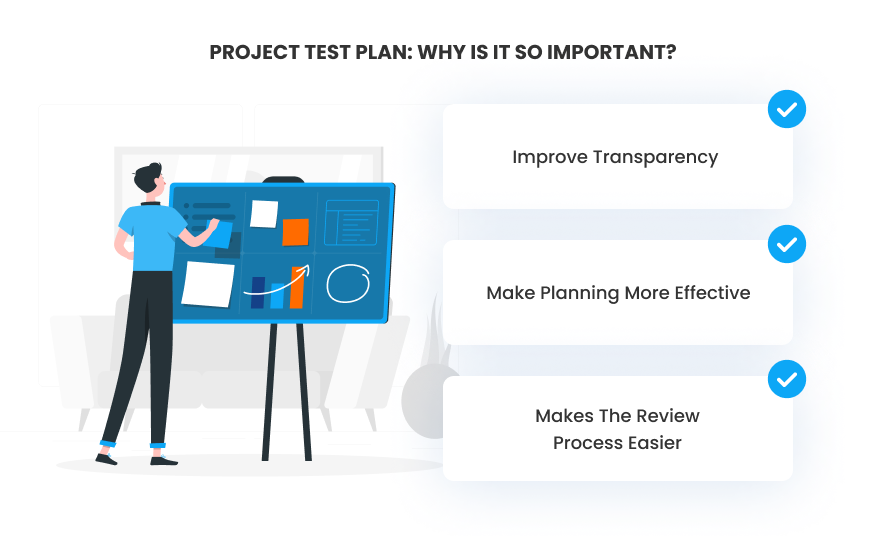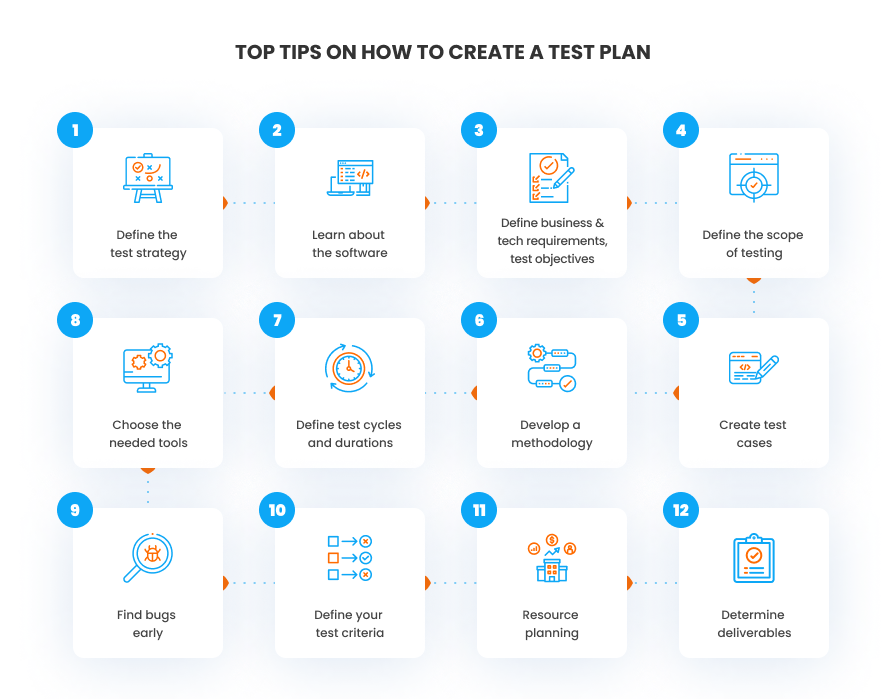Do you have a test plan? A detailed guide to writing a software test plan A to Z

Developing a detailed test plan is the most essential phase of any software testing process. Creating a precise and straightforward plan for the quality assurance process for your digital product allows you to check the entire app’s functionality and performance, as well as save plenty of time and costs while considering the entire company’s strategy. So, what is the main task of test planning? Below you will find the most critical data on test plan preparation and its key features.
Software Test Plan: Exploring the Basics
A test plan is a unique document that contains a list of all activities required for checking particular digital products. As a rule, this document includes the test strategy and schedule, the list of products that QA team will need to check, test cases, and the methods of testing, as well as the distribution of roles between the QA engineers. Before initiating any quality assurance process, a manager should prepare a product test plan.
Is Test Plan Similar to Test Cases?
It is necessary to distinguish between test plans and test cases. The most important thing about a test case is that it is performed under a single test scenario. As a result, a quality assurance professional might have a positive or negative test case for every scenario. The main goal of performing test cases is to identify bugs and errors, as well as demonstrate the app’s performance in case it works correctly. As a rule of thumb - test cases are part of the test plan. A test plan is a more complicated document that covers all activities connected to a certain testing project. As a rule, it will include the target market of the application, its goals, scope, deliverables, risks, start/end dates of the testing circle, and other information. This document is usually used not only by the QA team but also by other teams and stakeholders. To put it short, if you consider a test case as a pie, then a test plan is a recipe for cooking this pie.
Project Test Plan: Why Is It So Important?
 The test planning activities and full scope play a major role in the QA process. Here is a list of reasons why these activities are so important:
The test planning activities and full scope play a major role in the QA process. Here is a list of reasons why these activities are so important:
Improve Transparency
Effective communication between all the parties of the quality assurance process, managers, and stakeholders is crucial for a successful launch of any digital product. A clear and accurate plan allows for improving transparency in the QA process. The testing strategy, the schedules, details, and other information available in a plan can help managers and business leads understand the QA process better, know the exact dates of tests to be performed, what is the desired outcome, and other important data.
Make Planning More Effective
On the one hand, effective planning becomes much easier when the managers know what the teams are working on and why. On the other hand, the developers and engineers get an opportunity to focus on the key parameters and expected outcomes. The fact is that any QA process requires checking a wide number of features and parameters, and sometimes it is necessary to examine too many functions at the same time. Different QA testing plans might focus on different aspects. For example, some test cases might be targeted at checking network connectivity, while others designed exactly for stress testing.
Makes The Review Process Easier
The process of review in QA is about checking the actual outcomes with the expected results. The objective of testing in software engineering is to detect the differences between these two parameters and find the flaws, bugs, and imperfections to improve the quality of the final digital product.
Test Planning Vs Test Execution: What Is The Difference?
So, what is the purpose of the test plan? Not only does it includes a list of particular steps for checking a particular functionality, but it also contains a strategy and approach that should be followed by the team. In other words, the test plan guides the entire quality assurance process. The test execution is a narrower concept, where you need to follow the step-by-step execution of each test case from the list.

The process of composing a plan usually starts before or during the development phase. The process usually contains the following steps:
- Define the test strategy. It is important to have a unique test that fully meets all the necessary requirements. Having a “big picture” view of the QA process will help you make sure the chosen approach is in alignment with organizational needs and goals.
- Learn about the software. Another aspect is to understand the software you are going to check- its main goal, additional features, benefits, and the entire scope of functionality.
- Define business and technical requirements/test objectives. It is crucial to have a clear vision of the main goal of software testing before you start creating a test plan. Moreover, all technical and business requirements should also be taken into account.
- Define the scope of testing. The list of features or functionality to be checked will provide you with a clearer vision of what exactly you need to check.
- Create test cases. The process of creating test cases should be performed according to the scope of testing and the requirements confirmed during the previous steps.
- Develop a methodology. This is about choosing a model for testing. It is possible to select from Agile, Waterfall, or Iterative models, as well as Unit, Integration, System testing, or others.
- Define test cycles and durations. Planning test cycles and their durations are also a must for any QA plan.
- Choose the needed tools. Different types of testing usually require different tools. It is necessary to pick up the most fitting and up-to-date alternatives.
- Find bugs early. The earlier you detect bugs, the easier it is to fix them. This approach saves you time and money.
- Define your test criteria. It is about determining the list of test cases, acceptance criteria, and related procedures that will be used to determine whether they meet all the needed specifications.
- Resource planning. This is about making a decision whether you will use only in-house resources or also benefit from using external ones. In most cases, using internal resources only might not be enough to achieve all your testing goals. Choosing between crowd testing, remote or dedicated team is another important aspect of any test plan.
- Determine deliverables. The final stage of creating a test plan is describing the process of choosing the outcomes of testing.
What If You Don’t Have A Testing Plan?
Although having a test plan is crucial for the successful launch of a digital product, some companies might still miss it. So, what if you don’t have a plan? What could be the outcome?
- Mess with roles and responsibilities of the parties of the QA process.
- Failure to have a clear and understandable goal of testing.
- Missing deadlines and having no particular vision of when the QA process is completed.
- Undefined test scope might confuse QA professionals.
As a result, the company is at risk of receiving incomplete results that don’t reflect the real picture of the product’s performance. The results of the testing might also fail to meet the expectations of the managers and stakeholders, as well as lead to serious company losses.
Who Should Create the Test Plan?

It is crucial to make sure your test plan is not composed by the developers’ team. The reason is that one of the parts of this document contains a check-up of whether the developer correctly understood the product requirements. In other words, it is necessary to test the developer’s code. The best solution, in this case, is to use the professional QA experts in the team (QA lead or test manager) to get this job done. But what if you don’t have a test manager in your organization? In that case, you will need to outsource this task to a reputable company that specializes in quality assurance and test plan creation. Don’t just settle for any ‘software development outsourcing’ company. Make sure you choose a partner that specializes in the QA niche. Crowd-testing services might also become a perfect solution for this case since you will get an opportunity to get expert help from experienced testers and dedicated managers.
Why Choose Ubertesters?
Ubertesters is a team of professional quality assurance engineers, managers, and experts in various fields of testing. With years of expertise in the quality assurance niche, we are proud to have hundreds of satisfied customers. Our experts have advanced experience in creating test plans and test cases, as well as can handle any type of testing, including performance, exploratory, functional, location, regression, payment, localization, and others. Checking your product’s performance on real devices, carriers, and locations is also among our advantages. Want to know even more benefits? Contact us at sales@ubertesters.com for more details.

